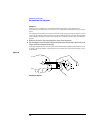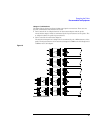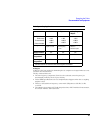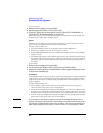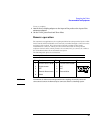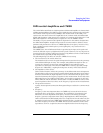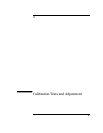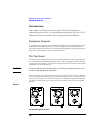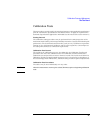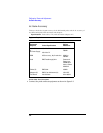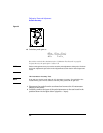
23
Operating the Probe
Recommended Test Equipment
Differential Amplifiers and CMRR
The 1141A Differential Probe is a high-impedance differential amplifier. A characteristic
of differential amplifiers is the ability to reject signals that are common to the two inputs.
The common mode rejection ratio (CMRR) is the measurement of this ability. It is
expressed as the ratio between the amplitudes of the common mode and differential
signals which product equal outputs. For example, if a common mode signal of 1 V and
differential signal of 1 mV both produce outputs of 1 mV, the CMRR is 1000:1.
The ability to reject common mode signals is dependent on the balance designed into
the differential amplifier. At higher frequencies it becomes harder to balance circuit
parasitics and parameters of devices so CMRR degrades as frequency increases. Also,
stray coupling increases with frequency and coupling may vary between the two
differential paths.
The CMRR of the 1141A Differential Probe is specified at the input of the probe and
cannot be affected expect by adjustments in the probe. However, the way the probe is
connected into the circuitry being tested can have a big influence in the overall result of
the measurement, especially at high frequencies.
The following things can affect the effective CMRR of a test setup:
• The connection to the circuit under test.
The method used to connect the probe is important because it involves the symmetry
of the differential input circuitry. For example, using different lengths of wire to
connect the circuit to the two probe inputs unbalances the inductance and
capacitance at the inputs. The effective CMRR will be reduced, especially at high
frequencies. Additionally, coupling from adjacent circuitry will be less balanced.
• The impedance of the source.
This is another instance where the symmetry of the differential circuit is important.
The impedance of the source forms a network with the input impedance of the source
forms a network with the input impedance of the connections and the probe. This
network determines the frequency response for the measurement. If each side of the
differential source has a different impedance, the frequency response of each side
will be different and the unbalance is reflected in a reduced CMRR. Of course, lower
source impedances have less effect on the frequency response of the measurement.
• The ground connection.
A poorly located ground connection allows ground loops to add to the common mode
signal.
• Frequency.
Frequency is the most important factor in CMRR only because all of the factors
mentioned above are frequency dependent. The unbalances of capacitance and
inductance are more important as frequency increases. Therefore, good high-
frequency practice is important when using a high impedance differential probe.
On the other hand, if the differential probe is ac coupled to the circuit under test (the
ac adapter is being used) the CMRR will be degraded below a certain frequency; the
lower the frequency the worse the CMRR. This is because unbalance in the series
capacitances of the ac coupler becomes more significant the lower the frequency.




